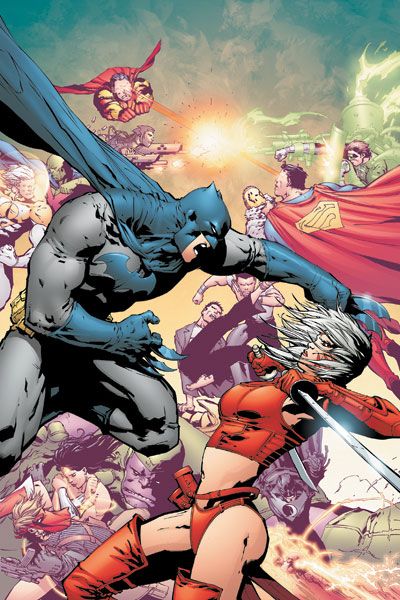I doubt anyone was clamoring for an apparently out-of-continuity mash-up of the DC and Wildstorm universes. I doubt anyone in the comic book community thought, "remember that issue of 'The Search for Ray Palmer' where the DC guys toured through the Wildstorm catalog? I'd like to see that, but as a six-issue fight scene, with the Legion of Super-Heroes thrown in, too!" But if you're DC and Wildstorm, and you're going to do it anyway, you might as well pick Keith Giffen to write it. At least he understands the absurdity of this type of story, and although he plays it straight, that Giffen subversive streak can't help but poke through.
I don't have much to say about the art in "DC/Wildstorm Dreamwar" #3. It's good, it's fine, it does the job. It's better than Ed Benes' work on this week's "Justice League of America," but it's basically mid-range Wildstorm superhero artwork. Lee Garbett is not very interested in backgrounds, but his figure work is serviceable. The art isn't going to make or break this series. But what about the story?
The story is exceedingly simple, but the motivations of the characters are strange, mysterious. Basically, what happens here -- and what has happened in the previous two issues -- is that various groups of DC characters (JLA, JSA, the Legion) arrive in the Wildstorm Universe and start punching away. There's a whole lot of punching. And some kicking. And stabbing (mostly in self-defense, by the Wildstorm characters, who are more likely to pack weapons than their DC counterparts). And energy blasting. For no apparent reason.
But Giffen makes the "no apparent reason" a plot point. The DC characters don't know why they're doing what they're doing. Someone called Chimera told them to do it (or Chimera Lad, where the Legion is concerned -- which is one of the bits of Giffen humor to creep through. It's the Legion, so obviously they would only respond to someone with "Lad" at the back of their name. "Chimera," not so much. "Chimera Lad," oh sure, they'll fly across the spacetime and fight on his behalf). In the earlier issues, the DC characters didn't even speak. They seemed like mindless constructs. But in issue #3, the characters coordinate battle plans, make puns, and generally act like themselves, except not quite. When Green Arrow dies, the JLA members barely seem to notice. When Element Lad is blasted in two, the Legionnaires seem dazed, but not overly emotional. And when Batman is slain, Bullseye and Elektra style, by the sword of Zealot, Superman begins to wake up a bit, and realize that something's not right here.
The series is called "Dreamwar," not because it's the war we've all dreamed about. We didn't stay up at night dreaming that Batman would one day face Zealot in batarang-to-sword combat (well, I sure didn't). It's called "Dreamwar" because this is all someone's weird dream. This isn't "really" happening. Green Arrow's not dead, and neither is Element Lad, and neither is Batman. Perhaps, if this were the first comic book you'd ever read, you might think that these characters gone for good. But obviously DC's not going to kill off Batman in a meaningless inter-company crossover non-event.
And, ironically, that's kind of the fun of this series. We often talk about writers and artists "playing around in the sandbox" with these corporately-owned characters. But most of the time, the "playing" part gets lost. Not with Giffen. He knows that this is all a lark, and though he has the characters act suitably self-important and stoic, he's just messing with them. He throws the geriatric JSA against the geriatric Tranquility gang. He has the innocent and naive paramilitary Silver Age Legion battle the cynical and lethal paramilitary Stormwatch. In the night sky, we see Amazons vs. Vampires -- "should be quite a show," says one Wetworks member, and he's right.
I'm sure Giffen will explain all of these strange plot events and shocking "deaths" within the next three issues. I'm sure Chimera will be some whacked-out crazy comic book fan with mental powers who has created constructs of his favorite characters or something along those lines. But until the inevitable explanation comes along and playtime is over, I'll enjoy this series for what it is: a giddy "Secret Wars"-style romp in the fields of DC and Wildstorm, where anything can happen because it's all just an imaginary story anyway. But, as the man once said, aren't they all?

